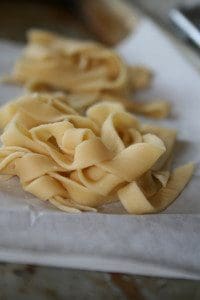
Los Angeles, Ca, September 29th, 2016-Making pasta seems like a daunting task but as I tell the five-year-olds I teach and my amazing brother who has taken up cooking, it’s a combination of four basic ingredients; egg, flour, water and salt. The biggest challenge is overcoming your fear.
Pasta requires time, attention, know-how and a reliable pasta machine. There are many fancy machines that help making pasta easier, but you pay for them. A standard old-fashioned pasta machine you crank by hand will do the job just as well. Old-fashioned crank machines need a solid place to anchor it to like a table or a counter top. A table not only keeps the pasta machine in place but it also allows you to stretch out the pasta to prevent clumping.

After you’ve solved how you’re going to roll out your dough, it’s time to get busy making it. There are many things that can go wrong while making pasta dough even though there a mere four ingredients. So to help you navigate through the problems take a look at the FAQ’s below and our solutions that go with them. If you have any more questions, please feel free to comment on this post. I will get back to you as soon as possible!
Problem #1: Too wet
Solution: If the dough is so sticky you can’t get it into a ball, add as much flour to the dough as you need to make it into a nice ball. Then let the dough rest for one to two hours. When you remove it from the refrigerator, break it into smaller sized balls. Lightly coat each ball with flour and then press the dough to a 1” thickness. Sprinkle flour into the pasta machine and begin rolling the dough through the machine. After you run the dough through, trifold it to fit into the machine properly. Lightly coat the dough with flour and run it through the machine again. Do this several times until you have smooth dough that is no longer too wet. Once it is ready, continue with the regular pasta making steps. (Be careful to not add too much flour and over work the dough; it can make your pasta tough)
Problem #2: Too dry
Solution: Pasta dough that’s too dry is tricky to fix, but the best way I have found is to wrap it with plastic and let it sit in the refrigerator. While it’s resting, it usually gets enough water from the cold moist air of the refrigerator. However, if you honestly think it needs more than that will give it, try adding water back into the dough by breaking it into smaller pieces. Add a little bit of water and slowly knead the water into the dough.
Problem #3 : The dough is brittle and breaks when it’s cut
Solution: Run your pasta through the two flat rollers multiple times before you begin cutting it into shapes and each time tri-fold it to make it thicker and remove any weak places in the dough.
Problem #4: The pasta dough sticks to my hands
Solution: Add flour to your hands and to the dough. You can remove dough from your hands by adding flour to the excess dough. However, I find that when you’re making pasta, if you do it correctly by the time you finish rolling it into a ball all of the dough will lift off your hands and go into the pasta dough.
Problem #5 : Pasta doesn’t taste like fresh Italian pasta
Solution: Italian pasta is different than American pasta because they use a double 0 flour also called 00 flour. It is lighter and more delicate than our flour and is similar to cake flour. You can special order 00 flour or you can try using cake or bread flour instead of the regular AP flour that is common in our grocery stores.
After all, if a five-year-old can make tasty, fresh homemade pasta then so can you. And I am also proud to say my brother did an amazing job with his homemade pasta and I am so proud of him and his amazing cooking skills that keep getting better and better.